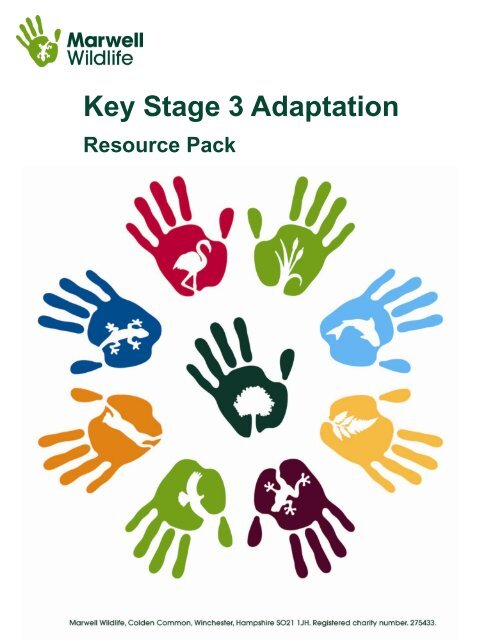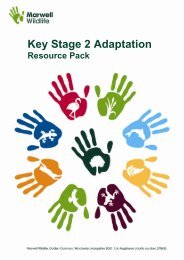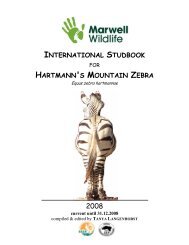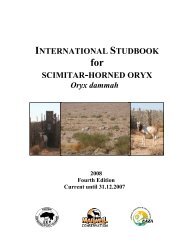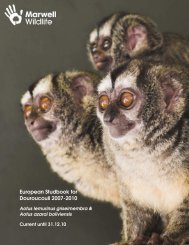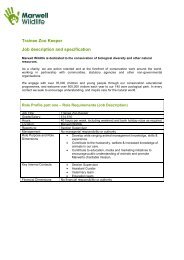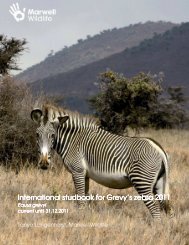KS3 Adaptation Resource Pack - Marwell Wildlife
KS3 Adaptation Resource Pack - Marwell Wildlife
KS3 Adaptation Resource Pack - Marwell Wildlife
Create successful ePaper yourself
Turn your PDF publications into a flip-book with our unique Google optimized e-Paper software.
Key Stage 3 <strong>Adaptation</strong><br />
<strong>Resource</strong> <strong>Pack</strong>
Contents Page<br />
Introduction 1<br />
National curriculum links 1<br />
Summary of resources 1<br />
Before your visit 3<br />
Park map (marked with trail animals) 4<br />
<strong>Adaptation</strong> trail – pupil pack 5<br />
Cold-blooded corner mini-trail – student worksheet 18<br />
Tropical World activity – Who am I? – student worksheet 19<br />
<strong>Adaptation</strong> Dominoes (15 cards) 20<br />
<strong>Adaptation</strong> post-visit activities 24<br />
Who is best adapted? – student worksheet 24<br />
Where do I live? – student worksheet 25<br />
Create your own animal 26<br />
Origami adaptation teller template 27<br />
How to make your origami adaptation teller 29<br />
Example of a finished origami adaptation teller design 30<br />
Activity answers 31<br />
<strong>Adaptation</strong> trail answers 31<br />
Cold-blooded corner mini-trail answers 34<br />
Tropical World Activity – Who am I? – answers 34<br />
Post visit activity – Where do I live? – answers 34<br />
<strong>Adaptation</strong> word cards 35<br />
Reference list 36<br />
Evaluation 36
Introduction<br />
This resource has been produced to support the teaching and learning of Key Stage 3<br />
<strong>Adaptation</strong> topics. It contains a number of activities that can be used in a variety of ways:<br />
• In school as part of your Scheme of Work<br />
• During an independent park visit to <strong>Marwell</strong> <strong>Wildlife</strong><br />
• As part of a visit to <strong>Marwell</strong> <strong>Wildlife</strong> that also involves the <strong>KS3</strong> <strong>Adaptation</strong> session run<br />
by the Science and Learning Centre.<br />
This resource contains:<br />
• An <strong>Adaptation</strong> Trail around <strong>Marwell</strong><br />
• Two activities that can be used at specific sites in the park (Cold-blooded Corner and<br />
Tropical World)<br />
• Two interactive games: <strong>Marwell</strong> versions of Top Trumps and Dominoes<br />
• Two post-visit activity sheets<br />
• An origami instruction and template set to summarise their understanding of<br />
adaptation to habitat in a creative way<br />
National Curriculum links:<br />
Sc3.3d – All living things show variation, can be classified and are interdependent,<br />
interacting with each other and their environment<br />
Sc4c – Use real-life examples as a basis for finding out about science<br />
Sc4e – Experience science outside the school environment<br />
Ge1.1a – Understanding the physical and human characteristics of real places<br />
Ge2.1b – Collect, record and display information<br />
Ge3f – Physical geography, physical processes and natural landscapes<br />
Ge4e – Undertake fieldwork investigations in different locations outside the classroom,<br />
individually and as part of a team<br />
Summary of resources<br />
<strong>Adaptation</strong> Trail – for use on a visit<br />
The <strong>Adaptation</strong> Trail is a journey of discovery through <strong>Marwell</strong> which allows students to<br />
develop and apply their knowledge and understanding of ‘adaptation’. It follows the main<br />
route around the park, taking in seventeen species from a range of habitats; this provides<br />
students with the opportunity to see and consider a range of adaptations. The route of the<br />
trail will pass toilet blocks and there is a picnic site and café approximately half way round to<br />
allow for a break or for lunch.<br />
1
Cold-blooded Corner Mini-trail – for use on a visit<br />
This can be added on to the main trail or done as a stand-alone sheet. It focuses upon some<br />
of the reptiles found in Cold-Blooded Corner at Encounter Village. The students link together<br />
the picture of the reptile, its name and its adaptations by looking at the animals and finding<br />
the correct information, clues for which should be available on the information signs.<br />
Tropical World Activity – Who Am I? – for use on a visit<br />
Again, this can be added on to the main trail or done as a stand-alone sheet. This clue-based<br />
activity is designed for the Tropical House. Students have to look at the different species<br />
within the tropical house and determine which species is the answer to the clues. Please note<br />
that there is a one-way route around the Tropical House and that students should be<br />
forewarned not to touch the plants as some of them are poisonous.<br />
<strong>Adaptation</strong> Dominoes – classroom based<br />
This consists of 15 domino cards to print out; each one with an animal photo on one half and<br />
the adaptations of a different animal on the other half, which need to be matched in turn. This<br />
could be played in groups and could be used as a starter or a plenary activity. Once all<br />
matched correctly, the dominoes should form a loop.<br />
<strong>Adaptation</strong> Post-visit Activity – Who is best adapted? – classroom based<br />
This activity has been designed to encourage pupils to think in greater depth about the<br />
animals they have seen and their adaptations. There is no right or wrong answer to this task,<br />
however it is important pupils try to justify their answers. This could be set up as a classroom<br />
debate whereby pupils try to persuade others their chosen animal is best adapted to its<br />
habitat. This could be used as a starter or plenary activity.<br />
<strong>Adaptation</strong> Post-visit Activity – Where do I live? – classroom based<br />
This activity involves pupils matching four different animals to their habitat based on their<br />
adaptations. Pupils should be encouraged to give reasons for their decisions that are linked<br />
to the animals’ adaptations (not answers like, ‘Because I know’). This could be used as a<br />
starter or plenary activity.<br />
Create your own Animal! – classroom based<br />
This activity requires pupils to apply their understanding in order to design their own animal<br />
adapted to their chosen habitat. Some questions have been provided to give pupils some<br />
guidelines to consider in their design process.<br />
2
Origami <strong>Adaptation</strong> Teller – classroom based<br />
A template is provided for pupils to create some origami linked to adaptation. The idea of this<br />
is to enable pupils to demonstrate their understanding of useful adaptations for different<br />
habitats in a creative way. It is a fun way of teaching other people about the different<br />
adaptations they have learnt about. A completed example is provided that could be cut out<br />
and made up to show pupils what they will be doing. An instruction sheet on how to fold this<br />
template into the finished product is also provided.<br />
Before your Visit<br />
It may be useful to familiarise yourself and the students with the variety of animals that we<br />
have here at <strong>Marwell</strong> <strong>Wildlife</strong>. Our website (www.marwell.org.uk) might be helpful and there<br />
are other links at the end of this document.<br />
If you are doing a trail round the park, students can use the information provided on signs,<br />
some picture clues on trail sheets and their own observations to complete their worksheets. A<br />
word card is included at the end of the pack to assist less able students.<br />
Please note that the crested porcupines and the black and white colobus monkeys are<br />
currently in the same enclosure. Giraffes have an indoor enclosure, where they will be in<br />
winter and wet weather, and two outdoor paddocks, in both of which there should be giraffes<br />
in good summer weather. The other animal which moves its location regularly is the Bactrian<br />
camel, which has a winter and a summer paddock – the summer one is near the playground.<br />
These are all marked on the map in the <strong>Adaptation</strong> Trail Booklet.<br />
This booklet can be printed out either on A4 sheets or in booklet format. The <strong>Adaptation</strong> Trail<br />
Booklet includes a map.<br />
3
1. 1 Humboldt penguin<br />
2. 2 Cheetah<br />
3. 3 Crested porcupine<br />
4. 4 Black and white colobus monkey<br />
5. 5 Giraffe<br />
6. 6 Sand cat<br />
7. 7 Ocelot<br />
8. 8 Coati<br />
Cold-blooded corner<br />
5<br />
Animals of <strong>Adaptation</strong> Trail<br />
9<br />
6<br />
10<br />
7<br />
9 9. Bactrian camel<br />
10 10. Bat eared fox<br />
11 11. Sulawesi crested macaque<br />
12 12. Siamang gibbon<br />
13 13. Malaysian giant stick insect<br />
14 14. Ring-tailed lemur<br />
15 15. Snow leopard<br />
16 16. Pygmy hippo<br />
17 17. Giant anteater<br />
Tropical World<br />
4<br />
8<br />
3, 4<br />
5<br />
2<br />
1<br />
9<br />
14<br />
16<br />
12<br />
13<br />
11<br />
17<br />
15
<strong>Adaptation</strong> Trail<br />
Welcome to <strong>Marwell</strong> <strong>Wildlife</strong>!<br />
Name:<br />
You are about to go on a journey of discovery around the park to find out more<br />
about how different animals are suited to their environment.<br />
First, let’s remind ourselves about the types of habitats animals might live in as<br />
this might affect their adaptations. See if you can match up the habitats below<br />
with the correct picture and characteristics:<br />
Rainforest<br />
Desert<br />
Mountain<br />
Savanna<br />
Coastal<br />
Hot and dry, little plant<br />
life<br />
Hot, enough rainfall for<br />
grass growth<br />
Hot, high rainfall, tall<br />
trees and dense<br />
vegetation<br />
Can be steep/rocky,<br />
temperature decreases<br />
with altitude<br />
Where the sea meets<br />
the land<br />
5
You will be looking at lots of different animals and the adaptations that they<br />
have to survive in different habitats.<br />
You will need to collect information on some of these animals and record it on<br />
the sheets provided – some of the information you will need is on signs on the<br />
animal enclosures; sometimes you have to watch the animals to work the<br />
answers out!<br />
1. HUMBOLDT PENGUIN<br />
What habitat does it live in?<br />
What are their wings like and what do these help penguins to do?<br />
What other adaptations help these birds to<br />
live? How?<br />
<strong>Adaptation</strong>:<br />
Useful because:<br />
<strong>Adaptation</strong>:<br />
Useful because:<br />
6
2. CHEETAH<br />
What habitat do these cats live in?<br />
Can you spot this pattern on the cheetah?<br />
How might this pattern be useful to cheetah?<br />
Look at the skulls by the cheetah enclosure. What type of teeth does a<br />
cheetah have?<br />
How might these teeth be useful to cheetah?<br />
How does a cheetah skull differ to a leopard or lion skull?<br />
How might this adaptation help cheetah?<br />
Can you spot any other adaptations cheetah have to<br />
help them survive in their habitat? What might these<br />
be useful for?<br />
7
3. CRESTED PORCUPINE<br />
The habitats these porcupines live in are<br />
Its most obvious adaptation is its<br />
These help it survive because<br />
4. BLACK AND WHITE COLOBUS MONKEY<br />
What habitat does it live in?<br />
Explain two adaptations these monkeys have to help<br />
them survive in their habitat:<br />
1.<br />
Useful for:<br />
2.<br />
Useful for:<br />
8
5. GIRAFFE<br />
This is the tallest land animal in the world.<br />
What habitat does it live in?<br />
What two adaptations do giraffes have to make them so tall?<br />
1.<br />
2.<br />
Give two reasons why being so tall is useful for a giraffe:<br />
1.<br />
2.<br />
A giraffe’s tongue is 46-50cm long.<br />
Why is this useful to giraffes?<br />
9
6. SAND CAT<br />
What type of habitat do these cats live in?<br />
Use the information boards to find out:<br />
a. How hot it gets during the day in the Sahara °C<br />
b. How cold it can get at night in the Sahara °C<br />
What main adaptation do sand cats have to<br />
help them live in this climate? How does this<br />
help them?<br />
How can it behave to help it survive<br />
these harsh temperatures? What adaptation<br />
does it have to allow it to do this?<br />
Survival strategy:<br />
<strong>Adaptation</strong>:<br />
10
7. OCELOT<br />
What habitat does it live in?<br />
In what two ways is an ocelot similar to a soldier?<br />
1.<br />
2.<br />
How do these two adaptations help it to survive in<br />
its habitat?<br />
8. RING-TAILED COATI<br />
What type of habitat does it live in?<br />
Can you identify and explain two adaptations that help it to live there?<br />
<strong>Adaptation</strong>:<br />
Useful because:<br />
<strong>Adaptation</strong>:<br />
Useful because:<br />
What special feature does this animal have that allows it to walk down trees<br />
headfirst?<br />
11
9. BACTRIAN CAMEL<br />
This species has 2 possible locations on the map, depending on the season. It<br />
is near Encounter Village in the winter and near the sand cats in the summer.<br />
Which habitat is the camel adapted for?<br />
Add annotations (labels with explanations) to the camel below to show what<br />
adaptations it has to help it survive in its habitat. An example has been done for<br />
you:<br />
Nostrils are slits<br />
that can open and<br />
close to keep sand<br />
out in sandstorms<br />
12
10. BAT-EARED FOX<br />
What type of habitat do these animals live in?<br />
“Why does the bat-eared fox follow the zebra?” – Using the signs around the<br />
enclosure complete the comic strip below by adding pictures/captions to<br />
answer this question.<br />
1. Zebras eat grass<br />
2. Zebras poo<br />
So why do bat-eared foxes follow zebras?<br />
Complete the table below to show what adaptations the bat-eared fox has to<br />
support this diet:<br />
<strong>Adaptation</strong><br />
Sketch of<br />
adaptation<br />
13<br />
5. Eggs hatch into larvae<br />
6. The larvae eat the<br />
zebra poo<br />
Useful because...
11. SULAWESI CRESTED MACAQUE<br />
What habitat do they live in?<br />
What special features do the macaques have?<br />
How are these useful?<br />
12. SIAMANG GIBBON<br />
In which type of habitat are these gibbons found?<br />
Identify 3 adaptations these gibbons have to help them move through the trees:<br />
1.<br />
2.<br />
3.<br />
Listen out for gibbons whooping as you go around the park! Siamang gibbons<br />
have an inflatable throat sac that allows their hooting to travel long distances.<br />
Why might this be useful in the habitat they live in?<br />
14
13. MALAYSIAN GIANT STICK INSECT<br />
What habitat do these insects live in?<br />
What main adaptation do they have to help them survive? Why is this so useful?<br />
Challenge: How many stick insects can you spot?!<br />
14. RING-TAILED LEMUR<br />
What habitat do ring-tailed lemurs live in?<br />
Suggest two adaptations that these lemurs have to help them live in this habitat<br />
1.<br />
2.<br />
At one end of the lemur house is a sign with flaps you can<br />
lift up. Use this to explain why lemurs have forward-facing<br />
eyes:<br />
15
15. SNOW LEOPARD<br />
The habitat you would find snow leopards in is<br />
Try to add at least 3 annotations to the snow leopard below to explain what<br />
adaptations it has to help it live in its habitat. An example has been done for you.<br />
In the box sketch the markings found on snow leopards.<br />
Explain how these markings might be useful to the snow<br />
leopard.<br />
16<br />
Strong legs/paws to catch<br />
its prey and help it move<br />
easily though rocky areas
16. PYGMY HIPPO<br />
What habitat does it live in?<br />
What adaptations does it have to allow it to hide underwater but still see, hear<br />
and breathe?<br />
What does the sticky substance produced by the pygmy hippo’s skin protect it<br />
from?<br />
17. GIANT ANTEATER<br />
In what habitats would you find these animals?<br />
What type of food does this animal eat?<br />
What two adaptations does it have that would help it to feed? How?<br />
<strong>Adaptation</strong>:<br />
This helps it feed because:<br />
<strong>Adaptation</strong>:<br />
This helps it feed because:<br />
17
TROPICAL WORLD – WHO AM I?<br />
Read the clues and track down these amazing plants and animals found in<br />
<strong>Marwell</strong>’s Tropical World, whilst discovering more about how they are adapted<br />
to their habitat.<br />
� I have 6 stalk-like legs<br />
� I am green/grey and small<br />
� I am very well<br />
camouflaged<br />
� My head looks similar to<br />
that of a horse<br />
I am a ................................<br />
...........................................<br />
...........................................<br />
1<br />
� I am very small<br />
� I have six legs<br />
� I don’t live alone<br />
� I have a special job that<br />
helps my colony to survive<br />
I am a ................................<br />
...........................................<br />
...........................................<br />
4<br />
� I have 4 legs<br />
� I have a long tail<br />
� I have claws that I can use to<br />
climb trees<br />
� I have a special flaps of skin<br />
behind my head that I can<br />
open into a fan to scare off<br />
attackers and to lose heat<br />
I am a ................................<br />
...........................................<br />
...........................................<br />
� I have four legs<br />
� I have rough scaly skin<br />
� When I float in the water, I<br />
leave only my nostrils, eyes,<br />
and ears above the surface.<br />
� I have a powerful tail to help<br />
me swim, and many sharp<br />
teeth<br />
I am a ................................<br />
...........................................<br />
...........................................<br />
2<br />
5<br />
19<br />
� I am green and black<br />
� I am not well camouflaged<br />
� My colour warns predators<br />
that I am poisonous<br />
� My skin is smooth and moist<br />
I am a ................................<br />
...........................................<br />
...........................................<br />
3<br />
� I am a climbing plant<br />
� I have small extra roots to<br />
attach to tree trunks<br />
� My leaves get bigger nearer<br />
the top, to use the available<br />
light<br />
� I have thick, waxy leaves so<br />
that I don’t lose too much<br />
water<br />
I am a ................................<br />
...........................................<br />
...........................................<br />
6
ADAPTATION DOMINOES<br />
There are 15 dominoes in the pack. The picture on one domino links to the information on<br />
another. They should end up as a loop at the end when they are all matched up.<br />
You may wish to print out 2 sets, divide your class into two groups and let them compete to<br />
finish the dominoes in the quickest time.<br />
Humboldt penguin<br />
Serval<br />
Crested porcupine<br />
20<br />
• I have small spots to camouflage in<br />
savannah grasses<br />
• My long, slim legs help me run very fast<br />
• I have a small head which helps me to<br />
be streamlined for speed<br />
• My long tail helps me to change<br />
direction, when I am chasing my prey<br />
• My wings are like flippers and help me<br />
swim<br />
• I have waterproof feathers<br />
• My body is a streamlined shape to help<br />
me swim through the water<br />
• I have black and white feathers so that<br />
predators cannot see me from above<br />
and below<br />
• My beak has special teeth to hold the<br />
fish that I catch for food<br />
• My light brown coat with black spots<br />
helps me to blend in with my habitat<br />
• I live in grasslands or savannahs<br />
• My long legs help me to jump into the<br />
air to catch birds and to run fast<br />
• I have very large ears so that I can hear<br />
my prey
Black and<br />
white colobus<br />
monkey<br />
Giraffe<br />
Ring-tailed<br />
coati<br />
Bactrian camel<br />
21<br />
• I have very long quills that are very<br />
sharp<br />
• My quills are hollow so when I am<br />
scared I can shake them to make a<br />
loud rattle sound<br />
• If I am being attacked, I run backwards<br />
at my attacker and stick my quills in<br />
them<br />
• I am mostly black with a very long white<br />
tail<br />
• I use my long tail to help me move<br />
through the trees<br />
• My long arms help me to swing from<br />
tree to tree<br />
• I have long fingers that I use to grip<br />
onto branches.<br />
• I am light brown with darker patches<br />
that look like crazy paving<br />
• My tongue is very long to help me<br />
reach food and it is blue<br />
• My lips are very tough as I like to eat<br />
leaves off very prickly trees<br />
• I am very tall as I have very long legs<br />
and a very long neck<br />
• I have strong legs and claws to help me<br />
move around woodland areas<br />
• I use my tail to help me to balance as I<br />
walk along branches<br />
• My snout (nose) is very flexible<br />
• My ankles can move 180º so that I can<br />
see below me when I am walking down<br />
trees
Tokay gecko<br />
Panther chameleon<br />
Sand cat<br />
Horse-headed grasshopper<br />
22<br />
• I can have a thick coat in winter to keep<br />
me warm and a thin coat in the summer<br />
to help me to stay cool<br />
• My nostrils can be closed during dust<br />
storms<br />
• I can drink up to 57 litres of water in<br />
one go<br />
• I have two humps where I store my fat<br />
• I have special hairs on my toes that<br />
help my feet stick to any surface, even<br />
glass<br />
• If I feel threatened I can drop my tail<br />
which will act as a distraction whilst I<br />
escape<br />
• My eyes work separately to each other<br />
so I can see all around me<br />
• I have a special long tongue that I use<br />
to stun and grab my prey<br />
• My toes allow me to grip onto small<br />
branches<br />
• I can change my colour to make me<br />
camouflaged or to show my mood<br />
• I live in sandy deserts<br />
• My fur is very special as it is so thick<br />
that it protects me from freezing<br />
temperatures at night and very hot<br />
temperatures during the day<br />
• I have strong legs so I can dig out prey<br />
and make burrows for me to shelter in
Siamang gibbon<br />
Poison dart frog<br />
Cheetah<br />
Snow leopard<br />
23<br />
• I am light brown so that I am<br />
camouflaged<br />
• I am very small<br />
• I look like the twigs on which I live<br />
• I am an insect<br />
• I spend most of my time up in the<br />
canopy of the forest<br />
• My legs are much shorter than my<br />
arms, which helps me to move from<br />
branch to branch<br />
• When I am on the ground I walk with<br />
my arms above my head to help me<br />
balance<br />
• I have black hair<br />
• I am camouflaged against the mountain<br />
where I live<br />
• My feet are very wide which helps me<br />
to move through the snow and across<br />
rocks<br />
• I have a very long and fluffy tail that I<br />
use for balance and to keep my face<br />
warm when I am asleep<br />
• I am not a mammal<br />
• I am small and live in the tropical<br />
rainforests<br />
• My colouring means that I am not well<br />
camouflaged<br />
• My black and green colour tells<br />
predators that they shouldn’t eat me as<br />
I am poisonous
<strong>Adaptation</strong> post-visit activities<br />
Who is best adapted?<br />
Rank the following 5 animals that you have hopefully seen on you visit to <strong>Marwell</strong> <strong>Wildlife</strong><br />
based on their adaptations.<br />
1 = Best adapted to their habitat<br />
5 = Least adapted to their habitat<br />
You must also give a reason for why you have ranked each animal the way you have<br />
Humboldt penguin<br />
I have ranked this as number ..... because<br />
Bactrian camel<br />
I have ranked this as number ..... because<br />
Sulawesi crested macaque<br />
I have ranked this as number ..... because<br />
Snow leopard<br />
I have ranked this as number ..... because<br />
Ring-tailed lemur<br />
I have ranked this as number ..... because<br />
24
Where do I live?<br />
Look at the following animals and their adaptations - less obvious adaptations have been labelled<br />
to help you. Can you match the animals to their habitat? Choose from the habitats below and give<br />
reasons for your choice based on the animals’ adaptations.<br />
Tail detaches if<br />
caught hold of by<br />
predator. Can regrow<br />
over time<br />
Thick fur<br />
Rainforest Coastal<br />
Desert<br />
Mountain<br />
Leopard gecko<br />
Sea otter<br />
Very good<br />
eyesight for<br />
seeing underwater<br />
and on land<br />
Stores excess<br />
fat in its tail<br />
Webbed feet<br />
Waterproof<br />
outer fur<br />
Habitat:<br />
I think the leopard gecko lives<br />
here because:<br />
Habitat:<br />
I think the ibex lives here<br />
because:<br />
Habitat:<br />
I think the sea otter lives here<br />
because:<br />
Habitat:<br />
I think the spider monkey lives<br />
here because:<br />
25<br />
Hooves have a hard rim,<br />
allowing them to gain<br />
good footholds and to<br />
grip rock<br />
Ibex<br />
Prehensile<br />
(gripping) tail<br />
Spider monkey
Create your own animal!<br />
Your challenge is to design a new animal that is perfectly adapted to the<br />
habitat it lives in. You can choose any of the habitats you have learnt about.<br />
Below are some questions you will need to consider before designing your<br />
animal.<br />
Questions to consider:<br />
1. Where will your animal live (habitat)? What are the main characteristics of<br />
that habitat? – e.g. Hot? Cold? Wet? Dry? Lots of vegetation? Not very<br />
much vegetation?<br />
2. What will your animal eat?<br />
3. How will your animal move?<br />
4. How will your animal communicate?<br />
5. Where will your animal sleep?<br />
6. Will your animal come out during the day, night or both?<br />
26
Origami adaptation teller<br />
Below is a template for making your own Origami <strong>Adaptation</strong> Teller! The idea is for you to<br />
make a fun way of teaching other people about the different adaptations animals may have for<br />
their habitat. The template is split into 4 different habitat areas (marked by the thick black<br />
lines). You need to choose 4 habitats, suggest 2 adaptations that animals in that habitat<br />
might have and provide an example of an animal who lives in that habitat. Then cut out your<br />
adaptation teller and use the instructions on the next page to make it up. You can then use it to<br />
teach your friends about different adaptations animals might have in different habitats!<br />
Habitat Name Habitat Picture<br />
Useful <strong>Adaptation</strong><br />
Useful <strong>Adaptation</strong><br />
Habitat Name Habitat Picture<br />
Useful <strong>Adaptation</strong> Useful <strong>Adaptation</strong><br />
Useful <strong>Adaptation</strong><br />
Habitat Picture<br />
27<br />
Useful <strong>Adaptation</strong><br />
Habitat Name<br />
Useful <strong>Adaptation</strong> Useful <strong>Adaptation</strong><br />
Habitat Name<br />
Habitat Picture
Origami adaptation teller<br />
Below is a template for making your own Origami <strong>Adaptation</strong> Teller! The idea is for you to<br />
make a fun way of teaching other people about the different adaptations animals may have for<br />
their habitat. The template is split into 4 different habitat areas (marked by the thick black<br />
lines). You need to choose 3 habitats, suggest 2 adaptations that animals in that habitat<br />
might have and provide an example of an animal who lives in that habitat (an example has<br />
been done for you). Then cut out your adaptation teller and use the instructions on the next<br />
page to make it up. You can then use it to teach your friends about different adaptations<br />
animals might have in different habitats!<br />
Habitat Name Habitat Picture<br />
Useful <strong>Adaptation</strong><br />
Useful <strong>Adaptation</strong><br />
Habitat Name Habitat Picture<br />
Waterproof<br />
feathers/fur<br />
Useful <strong>Adaptation</strong> Useful <strong>Adaptation</strong><br />
Useful <strong>Adaptation</strong><br />
Habitat Picture<br />
28<br />
Black &<br />
white<br />
camouflage<br />
Useful <strong>Adaptation</strong><br />
Habitat Name<br />
Useful <strong>Adaptation</strong> Useful <strong>Adaptation</strong><br />
Habitat Name<br />
Habitat Picture
Making your own origami adaptation teller<br />
Fold your paper<br />
in half and then<br />
unfold it along<br />
the dotted lines<br />
shown (design<br />
side facing down)<br />
Fold each of<br />
the corners in<br />
to the centre of<br />
your paper<br />
Turn your<br />
paper over<br />
29<br />
Fold each of the<br />
corners in to the<br />
centre of your<br />
paper<br />
Fold your<br />
paper in half<br />
down the<br />
dotted line<br />
Put your<br />
fingers in<br />
each of the 4<br />
pockets on<br />
either side of<br />
your paper to<br />
make your<br />
origami<br />
adaptation<br />
teller work
Example of a finished adaptation teller design<br />
Tail for<br />
balance<br />
Thick, warm<br />
fur<br />
Waterproof<br />
feathers/fur<br />
Small<br />
body to<br />
move through<br />
dense vegetation<br />
30<br />
Black &<br />
white<br />
camouflage<br />
Long<br />
Fingers for<br />
gripping branches<br />
Large<br />
feet to<br />
spread weight<br />
Fat stored in<br />
hump or tail
Activity answers<br />
<strong>Adaptation</strong> trail<br />
1. Humboldt penguin<br />
Habitat: Rocky coasts and cool waters<br />
Wings: Act as flippers to help them swim<br />
Other adaptations: Beak has small teeth to keep hold of fish; waterproof feathers; streamlined body<br />
to move quickly through water; black and white camouflage so can’t be easily seen by predators<br />
2. Cheetah<br />
Habitat: Desert, grasslands, bushveld, mountainous areas<br />
Pattern useful for: Camouflage – helps them to hide from their prey in savanna grasses<br />
Teeth: Big teeth – sharp canines, strong incisors – used for catching and eating their prey<br />
Skull: Smaller than leopard/lion skull – helps cheetah to be streamlined for running at speed<br />
Other adaptations: Long, slim legs for running fast; Long flat tail that allows it to change direction<br />
when chasing its prey at speed<br />
3. Crested porcupine<br />
Habitats: Many habitats from forest to desert<br />
Obvious adaptation: Quills<br />
Helps it survive by: Defence against predators, can shake them to make them rattle or run at<br />
attacker and stick quills into them<br />
4. Black and white colobus monkey<br />
Habitat: Rainforest<br />
<strong>Adaptation</strong>s: Long arms – for swinging between trees, moving along branches; Long tail – acts as a<br />
brake or used for balance<br />
5. Giraffe<br />
Habitat: Savanna or dry, open country and woodland<br />
<strong>Adaptation</strong>s to make it tall: Long legs; Long neck<br />
Why being tall is useful: Helps giraffe to reach food; Can look out for danger<br />
Long tongue: Useful for grabbing and picking leaves to eat<br />
6. Sand cat<br />
Habitat: Sandy desert<br />
How hot?: 58°C<br />
How cold?: -5°C or -25°C (winter)<br />
<strong>Adaptation</strong> to survive climate: Special solid, dense fur that insulates them<br />
Survival strategy: Digs burrows to get shade;<br />
<strong>Adaptation</strong> for this – Strong legs<br />
31
7. Ocelot<br />
Habitat: Forests, scrubland and savanna<br />
Similarities to a soldier: Waterproof coat; Camouflaged (Found on information board)<br />
How these similarities help ocelot to survive in its habitat: Oily coat to waterproof it in wet<br />
rainforest; Uses colours and patterns on its coat to camouflage it to help it hide from its prey<br />
8. Ring-tailed coati<br />
Habitat: Forests and woods<br />
<strong>Adaptation</strong>s: Strong short legs and claws to help it climb; Narrow nose to search for food; Thick fur to<br />
keep it warm; Long tail to help it balance<br />
Special feature: They can turn their ankles 180° (Found on information board)<br />
9. Bactrian camel<br />
Habitat: Semi-arid to arid plains, grasslands and desert<br />
<strong>Adaptation</strong>s: Wide feet to spread out weight and stop camel sinking in the sand; Hump to store fat<br />
when food and water is scarce; Long eyelashes to keep sand out of eyes; Sandy coloured for<br />
camouflage<br />
10. Bat-eared fox<br />
Habitat: Savanna, plains, grassland and steppes<br />
1. Zebras eat grass<br />
2. Zebras poo<br />
3. Dung beetles roll up<br />
the poo<br />
4. Dung beetles lay their<br />
eggs into the poo<br />
5. Eggs hatch into larvae<br />
6. The larvae eat the<br />
zebra poo<br />
7. Bat-eared foxes love<br />
to eat dung beetle larvae<br />
Why do bat-eared foxes follow zebras? Where there are zebras there is fox food!<br />
<strong>Adaptation</strong>s: Big ears to listen for and find underground bugs; Needle-like teeth to eat bugs more<br />
easily and quickly as need to eat really fast to fill up on bugs<br />
11. Sulawesi crested macaque<br />
Habitat: Tropical forest<br />
Special features: Crest on head – raises when anxious/alarmed; Pink bottom – perhaps helps them<br />
see each other better in the forest – becomes bigger on a female when she is ready to breed; Cheek<br />
pouches – can hold as much food as stomach<br />
32
12. Siamang gibbon<br />
Habitat: Tropical rainforest<br />
<strong>Adaptation</strong>s: Long arms for swinging through trees; Long fingers to grip branches; Forward facing<br />
eyes to judge distances<br />
Why might whooping be useful?: To communicate with each other in dense rainforest; to mark their<br />
territory<br />
13. Malaysian giant stick insect<br />
Habitat: Forests<br />
Main adaptation: Camouflage – helps them to hide from predators<br />
14. Ring-tailed lemurs<br />
Habitat: Scrub and forest<br />
<strong>Adaptation</strong>s: Long tail for balance; Long fingers for gripping branches<br />
Forward facing eyes: For judging distances when moving through trees<br />
15. Snow leopard<br />
Habitat: Cold mountains<br />
<strong>Adaptation</strong>s: Thick fur to protect against the cold; Large paws to spread weight so it can move easily<br />
through the snow; Long tail for balance when moving through rocky areas; Furry tail can be wrapped<br />
over the face to keep it warm when resting; Large teeth for killing and eating prey<br />
Markings: Help snow leopard camouflage to help it hide from and sneak up on its prey<br />
16. Pygmy hippo<br />
Habitat: Wet forests, swamps and streams<br />
<strong>Adaptation</strong>s for hiding under water: Their ears, eyes and nose are on the top of their head<br />
Sticky substance protects it from: The sun – acts as a kind of sunscreen<br />
17. Giant anteater<br />
Habitat: Grasslands and forests<br />
Diet: Ants, beetles, termites and fruit<br />
<strong>Adaptation</strong>s: Strong legs and claws to break into termite mounds/reach ants/termites; Long nose to<br />
sense ants/termites; Long tongue to pick up ants/termites<br />
33
Cold-blooded Corner mini-trail answers<br />
Panther Chameleon<br />
• My long tongue with a sticky tip shoots out very fast to catch insects<br />
• My red, green and white skin colour changes for camouflage or to show my<br />
moods<br />
• Each of my eyes can look round on its own, which helps me find insect food<br />
Egyptian tortoise:<br />
• I have a hard shell to protect against predators<br />
• Small round size helps me to heat up quickly in the sun after a cold night in<br />
the desert<br />
• My claws are good for digging and burying eggs in the sand in North Africa<br />
Gila monster:<br />
• I store fat in my tail for use in winter months, in western US deserts<br />
• My short black legs with long claws help to dig up a meal or make a burrow<br />
• My striking pink and black colouring warns that I am venomous<br />
Madagascar tree boa:<br />
• I kill my prey by tightening my powerful coils round the victim’s body<br />
• I eat small mammals and birds, opening my jaw wide to swallow animals<br />
whole<br />
• I am green, grey and black – good camouflage to live in forests!<br />
Tropical World activity – Who am I? – Answers<br />
1. Horse-headed grasshopper<br />
2. Frilled lizard<br />
3. Poison arrow frog<br />
4. Leaf-cutter ant<br />
5. West African dwarf crocodile<br />
POST-VISIT ACTIVITY – WHERE DO I LIVE? – Answers<br />
Leopard gecko – desert<br />
Ibex – mountains<br />
Sea otter – coastal habitats<br />
Spider monkey - rainforest<br />
34
<strong>Adaptation</strong> Word Card<br />
ankles beak bottom cheek claws ears feet<br />
fingers flippers fur eyes hump legs neck<br />
paws pouches quills snout stomach tail<br />
ant leaves rocks prey predator termite<br />
trees alarmed anxious bushy fat<br />
forward-facing large long raised small<br />
streamlined strong thick thin visible webbed<br />
attack balance camouflage catch defend<br />
keep warm pick reach swing swim spread weight<br />
Habitats (where animals live)<br />
desert savannah tropical rainforest grassland<br />
arid/semi-arid plains mountains woodlands<br />
<strong>Adaptation</strong> Word Card<br />
ankles beak bottom cheek claws ears feet<br />
fingers flippers fur eyes hump legs neck<br />
paws pouches quills snout stomach tail<br />
ant leaves rocks prey predator termite<br />
trees alarmed anxious bushy fat<br />
forward-facing large long raised small<br />
streamlined strong thick thin visible webbed<br />
attack balance camouflage catch defend<br />
keep warm pick reach swing swim spread weight<br />
Habitats (where animals live)<br />
desert savannah tropical rainforest grassland<br />
arid/semi-arid plains mountains woodlands<br />
35
References<br />
General species information for animals at <strong>Marwell</strong>:<br />
http://www.marwell.org.uk/zoo_guide/encyclopaedia.asp?css=1<br />
http://www.bbc.co.uk/nature/wildfacts/animals_a_z.shtml<br />
http://www.bbc.co.uk/nature/animals/<br />
http://www.arkive.org/<br />
Evaluation<br />
Please let us have some feedback when you have used this resource, so that we can<br />
improve our resources in the future.<br />
We would like to know:<br />
How helpful have you found it?<br />
Which were the best parts or activities?<br />
Which were the least useful?<br />
Did you have any problems with it?<br />
If so, what were they?<br />
Have you any more comments or suggestions?<br />
Please e-mail any feedback to education@marwell.org.uk.<br />
Thank you very much for your help!<br />
36


